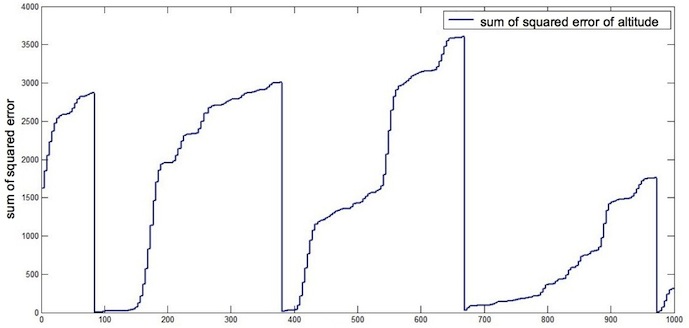Difference between revisions of "Module/FlightBenchmark"
| Line 6: | Line 6: | ||
The sum of squared error can by reseted by changing the boolean variable benchm_reset to zero (will turn back to 1 automatically after it has done the reset). This can also be used in a flight plan, which allows a flight plan with auto-reset. So it is possible to fly an oval or a eight figure with a sum of squared error that will be reseted at the very same point of the figure. | The sum of squared error can by reseted by changing the boolean variable benchm_reset to zero (will turn back to 1 automatically after it has done the reset). This can also be used in a flight plan, which allows a flight plan with auto-reset. So it is possible to fly an oval or a eight figure with a sum of squared error that will be reseted at the very same point of the figure. | ||
[[Image: | [[Image:SumOfSquaredErrorOfAltitude.jpg]] | ||
==Module Infos== | ==Module Infos== | ||
Revision as of 13:03, 15 August 2011
Description
This module allows a quantitative assessment of the flight. It calculates the sum of squared error of the two-dimensional course (x / y), the altitude and true airspeed. The sum of squared error of the course and altitude were separated, because they are regulated separately, and so they dependent on various parameters. The module was written to optimize the control parameters and has already been used successfully.
The measurement is not started until about the variable benchm_go is set to 1.
The sum of squared error can by reseted by changing the boolean variable benchm_reset to zero (will turn back to 1 automatically after it has done the reset). This can also be used in a flight plan, which allows a flight plan with auto-reset. So it is possible to fly an oval or a eight figure with a sum of squared error that will be reseted at the very same point of the figure.
Module Infos
ModuleXML
- flight_benchmark.xml
Code- and headerfile
- sw/airborne/modules/benchmark
Settings file
- benchmark.xml
Airframe Adjustments
The code is aviable to download in the ?? branch at: -ToDo-
- (1) Insert the software module in the airframe:
<modules>
<load name="flight_benchmark.xml">
<define name="BENCHMARK_AIRSPEED"/>
<define name="BENCHMARK_ALTITUDE"/>
<define name="BENCHMARK_POSITION"/>
<define name="BENCHMARK_TOLERANCE_AIRSPEED" value="0."/>
<define name="BENCHMARK_TOLERANCE_ALTITUDE" value="0."/>
<define name="BENCHMARK_TOLERANCE_POSITION" value="0."/>
</load>
</modules>
- Legend:
- Define BENCHMARK_AIRSPEED to enable airspeed benchmarking (only with airspeed module)
- Define BENCHMARK_ALTITUDE to enable altitude benchmarking.
- Define BENCHMARK_POSITION to enable position (x/y) benchmarking. (shortest error to the path)
- BENCHMARK_TOLERANCE_... define the tolerated value where the sum of squared error won't change. Set to zero to have no tolerance.
- Legend:
- (2) Add the settings XML to the settings list: benchmark.xml
- (3) Now you can turn on the calculations by setting the benchm_go to 1 (in GCS under benchamrk)
Example configurations in flightplan for auto-reset
- (1) Add this to your flightplan:
<flight_plan alt="............your configurations.............">
<header>
#include "modules/benchmark/flight_benchmark.h"
</header>
</flight_plan>
- (2) Add this block to the blocks section:
<block group="base_pattern" name="Oval Bench" strip_button="Oval Bench(wp 1-2)" strip_icon="oval.png">
<oval p1="Ov1" p2="Ov2" radius="nav_radius" until="nav_oval_count > 0"/>
<set value="1" var="benchm_reset"/>
<deroute block="Oval Bench"/>
</block>
- (3) Make shure that you've named your points right.
Modify figure eight to use the until function in flightplan
If you want to use the figure eight with auto-reset you have to modify the flight plan generator to activate the until function.
Or download and replace it from: https://github.com/Bruzzlee/paparazzi/blob/master/sw/tools/gen_flight_plan.ml
- (1) Open the flight plan generator in a text editor:
/sw/tools/gen_flight_plan.ml
- (2) Now you have to replace this part (line 429)
| "eight" -> stage (); lprintf "nav_eight_init();\n"; lprintf "NextStageAndBreak();\n"; left (); stage (); let center = get_index_waypoint (ExtXml.attrib x "center") index_of_waypoints and turn_about = get_index_waypoint (ExtXml.attrib x "turn_around") index_of_waypoints in let r = parsed_attrib x "radius" in let _vmode = output_vmode x center "" in lprintf "Eight(%s, %s, %s);\n" center turn_about r;
- (3) with this part
| "eight" ->
stage ();
lprintf "nav_eight_init();\n";
lprintf "NextStageAndBreak();\n";
left ();
stage ();
let center = get_index_waypoint (ExtXml.attrib x "center") index_of_waypoints
and turn_about = get_index_waypoint (ExtXml.attrib x "turn_around") index_of_waypoints in
let r = parsed_attrib x "radius" in
let _vmode = output_vmode x center "" in
lprintf "Eight(%s, %s, %s);\n" center turn_about r;
begin
try
let c = parsed_attrib x "until" in
lprintf "if (%s) NextStageAndBreak();\n" c
with
ExtXml.Error _ -> ()
end;
- (4) Now you can use this block in the flightplan:
<block key="F7" name="Eight Bench" strip_button="Figure 8 (wp 1-2)" strip_icon="eight.png" group="base_pattern">
<eight center="8C" radius="nav_radius" turn_around="8T" until="nav_oval_count > 0"/>
<set value="1" var="benchm_reset"/>
<deroute block="Eight Bench"/>
</block>
